Histogram - Histogram plot - MATLAB (original) (raw)
Description
Histograms are a type of bar plot that group data into bins. After you create a Histogram object, you can modify aspects of the histogram by changing its property values. This is particularly useful for quickly modifying the properties of the bins or changing the display.
Creation
Syntax
Description
histogram([X](#buhzm%5Fz-1-X)) creates a histogram plot of X. The histogram function uses an automatic binning algorithm that returns bins with a uniform width, chosen to cover the range of elements in X and reveal the underlying shape of the distribution. histogram displays the bins as rectangular bars such that the height of each rectangle indicates the number of elements in the bin.
histogram([X](#buhzm%5Fz-1-X),[nbins](#buhzm%5Fz-1-nbins)) specifies the number of bins.
histogram([X](#buhzm%5Fz-1-X),[edges](#buhzm%5Fz-1-edges)) sorts X into bins with bin edges specified in a vector.
histogram('BinEdges',[edges](#buhzm%5Fz-1-edges),'BinCounts',[counts](#buhzm%5Fz-1-counts)) plots the specified bin counts and does not do any data binning.
histogram([C](#buhzm%5Fz-1-C)) plots a histogram with a bar for each category in categorical arrayC.
histogram([C](#buhzm%5Fz-1-C),[Categories](#buhzm%5Fz-1%5Fsep%5Fshared-Categories)) plots only a subset of categories in C.
histogram('Categories',[Categories](#buhzm%5Fz-1%5Fsep%5Fshared-Categories),'BinCounts',[counts](#buhzm%5Fz-1-counts)) manually specifies categories and associated bin counts.histogram plots the specified bin counts and does not do any data binning.
histogram(___,[Name,Value](#namevaluepairarguments)) specifies additional parameters using one or more name-value arguments for any of the previous syntaxes. For example, specifyNormalization to use a different type of normalization. For a list of properties, see Histogram Properties.
histogram([ax](#buhzm%5Fz-1-ax),___) plots into the specified axes instead of into the current axes (gca). ax can precede any of the input argument combinations in the previous syntaxes.
[h](#buhzm%5Fz-1-h) = histogram(___) returns a Histogram object. Use this to inspect and adjust the properties of the histogram. For a list of properties, seeHistogram Properties.
Input Arguments
X — Data to distribute among bins
vector | matrix | multidimensional array
Data to distribute among bins, specified as a vector, matrix, or multidimensional array. histogram treats matrix and multidimensional array data as a single column vector,X(:), and plots a single histogram.
histogram ignores all NaN andNaT values. Similarly,histogram ignores Inf and-Inf values, unless the bin edges explicitly specify Inf or -Inf as a bin edge. Although NaN, NaT,Inf, and -Inf values are typically not plotted, they are still included in normalization calculations that include the total number of data elements, such as'probability'.
Note
If X contains integers of typeint64 or uint64 that are larger than flintmax, then it is recommended that you explicitly specify the histogram bin edges.histogram automatically bins the input data using double precision, which lacks integer precision for numbers greater than flintmax.
Data Types: single | double | int8 | int16 | int32 | int64 | uint8 | uint16 | uint32 | uint64 | logical | datetime | duration
C — Categorical data
categorical array
Categorical data, specified as a categorical array.histogram does not plot undefined categorical values. However, undefined categorical values are still included in normalization calculations that include the total number of data elements, such as 'probability'.
Data Types: categorical
nbins — Number of bins
positive integer
Number of bins, specified as a positive integer. If you do not specifynbins, then histogram determines the number of bins from the values inX.
If you specify nbins withBinMethod, BinWidth orBinEdges, histogram only honors the last parameter.
Example: histogram(X,15) creates a histogram with 15 bins.
edges — Bin edges
vector
Bin edges, specified as a vector. edges(1) is the leading edge of the first bin, and edges(end) is the trailing edge of the last bin.
Each bin includes the leading edge, but does not include the trailing edge, except for the last bin which includes both edges.
For datetime and duration data,edges must be a datetime orduration vector in monotonically increasing order.
If you specify counts, thenedges must be a row vector.
Data Types: single | double | int8 | int16 | int32 | int64 | uint8 | uint16 | uint32 | uint64 | logical | datetime | duration
Note
This option only applies to categorical histograms.
Categories included in histogram, specified as a cell array of character vectors, categorical array, string array, or pattern scalar.
- If you specify an input categorical array
C, then by default,histogramplots a bar for each category inC. In that case, useCategoriesto specify a unique subset of the categories instead. - If you specify bin counts, then
Categoriesspecifies the associated category names for the histogram.
Example: h = histogram(C,{'Large','Small'}) plots only the categorical data in the categories 'Large' and 'Small'.
Example: histogram(C,"Y" + wildcardPattern) plots data in the categories whose names begin with the letterY.
Example: histogram('Categories',{'Yes','No','Maybe'},'BinCounts',[22 18 3]) plots a histogram that has three categories with the associated bin counts.
Example: h.Categories queries the categories that are in histogram object h.
Data Types: cell | categorical | string | pattern
counts — Bin counts
vector
Bin counts, specified as a vector. Use this input to pass bin counts to histogram when the bin counts calculation is performed separately and you do not want histogram to do any data binning.
The size of counts must be equal to the number of bins.
- For numeric histograms, the number of bins is
length(edges)-1. - For categorical histograms, the number of bins is equal to the number of categories.
Example: histogram('BinEdges',-2:2,'BinCounts',[5 8 15 9])
Example: histogram('Categories',{'Yes','No','Maybe'},'BinCounts',[22 18 3])
ax — Target axes
Axes object | PolarAxes object
Target axes, specified as an Axes object or aPolarAxes object. If you do not specify the axes and if the current axes are Cartesian axes, then thehistogram function uses the current axes (gca). To plot into polar axes, specify thePolarAxes object as the first input argument or use the polarhistogram function.
Name-Value Arguments
Specify optional pairs of arguments asName1=Value1,...,NameN=ValueN, where Name is the argument name and Value is the corresponding value. Name-value arguments must appear after other arguments, but the order of the pairs does not matter.
Example: histogram(X,BinWidth=5)
Before R2021a, use commas to separate each name and value, and enclose Name in quotes.
Example: histogram(X,'BinWidth',5)
Bins
Width of bins, specified as a positive scalar. If you specify BinWidth, then Histogram can use a maximum of 65,536 bins (or 216). If the specified bin width requires more bins, thenhistogram uses a larger bin width corresponding to the maximum number of bins.
- For
datetimeanddurationdata,BinWidthcan be a scalar duration or calendar duration. - If you specify
BinWidthwithBinMethod,NumBins, orBinEdges,histogramonly honors the last parameter. - This option does not apply to categorical data.
Example: `histogram`(X,'BinWidth',5) uses bins with a width of 5.
Bin limits, specified as a two-element vector, [bmin,bmax]. The first element indicates the first bin edge. The second element indicates the last bin edge.
This option computes using only the data that falls within the bin limits inclusively, X>=bmin & X<=bmax.
This option does not apply to categorical data.
Example: `histogram`(X,'BinLimits',[1,10]) bins only the values in X that are between 1 and10 inclusive.
Selection mode for bin limits, specified as 'auto' or 'manual'. The default value is 'auto', so that the bin limits automatically adjust to the data.
- If you specify
BinLimitsorBinEdges, thenBinLimitsModeis set to'manual'. SpecifyBinLimitsModeas'auto'to rescale the bin limits to the data. - This option does not apply to histograms of categorical data.
Binning algorithm, specified as one of the values in this table.
| Value | Description |
|---|---|
| 'auto' | The default 'auto' algorithm chooses a bin width to cover the data range and reveal the shape of the underlying distribution. |
| 'scott' | Scott’s rule is optimal if the data is close to being normally distributed. This rule is appropriate for most other distributions, as well. It uses a bin width of3.5*std(X(:))*numel(X)^(-1/3). |
| 'fd' | The Freedman-Diaconis rule is less sensitive to outliers in the data, and might be more suitable for data with heavy-tailed distributions. It uses a bin width of2*iqr(X(:))*numel(X)^(-1/3). |
| 'integers' | The integer rule is useful with integer data, as it creates a bin for each integer. It uses a bin width of 1 and places bin edges halfway between integers.To avoid accidentally creating too many bins, you can use this rule to create a limit of 65536 bins (216). If the data range is greater than 65536, then the integer rule uses wider bins instead.'integers' does not support datetime or duration data. |
| 'sturges' | Sturges’ rule is popular due to its simplicity. It chooses the number of bins to beceil(1 + log2(numel(X))). |
| 'sqrt' | The Square Root rule is widely used in other software packages. It chooses the number of bins to beceil(sqrt(numel(X))). |
histogram adjusts the number of bins slightly so that the bin edges fall on "nice" numbers, rather than using these exact formulas.
For datetime or duration data, specify the binning algorithm as one of these units of time.
| Value | Description | Data Type |
|---|---|---|
| "second" | Each bin is 1 second. | datetime and duration |
| "minute" | Each bin is 1 minute. | datetime and duration |
| "hour" | Each bin is 1 hour. | datetime and duration |
| "day" | Each bin is 1 calendar day. This value accounts for daylight saving time shifts. | datetime and duration |
| "week" | Each bin is 1 calendar week. | datetime only |
| "month" | Each bin is 1 calendar month. | datetime only |
| "quarter" | Each bin is 1 calendar quarter. | datetime only |
| "year" | Each bin is 1 calendar year. This value accounts for leap days. | datetime and duration |
| "decade" | Each bin is 1 decade (10 calendar years). | datetime only |
| "century" | Each bin is 1 century (100 calendar years). | datetime only |
- If you specify
BinMethodfordatetimeordurationdata, thenhistogramcan use a maximum of 65,536 bins (or 216). If the specified bin duration requires more bins, thenhistogramuses a larger bin width corresponding to the maximum number of bins. - If you specify
BinLimits,NumBins,BinEdges, orBinWidth, thenBinMethodis set to'manual'. - If you specify
BinMethodwithBinWidth,NumBinsorBinEdges,histogramonly honors the last parameter. - This option does not apply to categorical data.
Example: `histogram`(X,'BinMethod','integers') centers the bins on integers.
Categories
Category display order, specified as 'data', 'ascend', or 'descend'.
'data'— Use the category order in the input dataC.'ascend'— Display the histogram with increasing bar heights.'descend'— Display the histogram with decreasing bar heights.
This option only works with categorical data.
Number of categories to display, specified as a scalar. You can change the ordering of categories displayed in the histogram using the 'DisplayOrder' option.
This option only works with categorical data.
Toggle summary display of data belonging to undisplayed categories, specified as'on' or 'off', or as numeric or logical1 (true) or 0 (false). A value of 'on' is equivalent totrue, and 'off' is equivalent tofalse. Thus, you can use the value of this property as a logical value. The value is stored as an on/off logical value of type matlab.lang.OnOffSwitchState.
- Set this option to
'on'to display an additional bar in the histogram with the name'Others'. This extra bar counts all elements that do not belong to categories displayed in the histogram. - You can change the number of categories displayed in the histogram, as well as their order, using the
'NumDisplayBins'and'DisplayOrder'options. - This option only works with categorical data.
Data
Type of normalization, specified as one of the values in this table. For each bini:
- vi is the bin value.
- ci is the number of elements in the bin.
- wi is the width of the bin.
- N is the number of elements in the input data. This value can be greater than the binned data if the data contains missing values, such as
NaN, or if some of the data lies outside the bin limits.
| Value | Bin Values | Notes |
|---|---|---|
| 'count' (default) | vi=ci | Count or frequency of observations.Sum of bin values is at most numel(X), or sum(ismember(X(:),'Categories')) for categorical data. The sum is less than this only when some of the input data is not included in the bins. |
| 'probability' | vi=ciN | Relative probability.The number of elements in each bin relative to the total number of elements in the input data is at most 1. |
| 'percentage' | vi=100*ciN | Relative percentage.The percentage of elements in each bin is at most 100. |
| 'countdensity' | vi=ciwi | Count or frequency scaled by width of bin.For categorical data, this is the same as'count'.'countdensity' does not supportdatetime orduration data.The sum of the bin areas is at most numel(X). |
| 'cumcount' | vi=∑j=1icj | Cumulative count, or the number of observations in each bin and all previous bins.N(end) is at mostnumel(X), orsum(ismember(X(:),'Categories')) for categorical data. |
| 'pdf' | vi=ciN ⋅ wi | Probability density function estimate.For categorical data, this is the same as'probability'.'pdf' does not supportdatetime orduration data.The sum of the bin areas is at most1. |
| 'cdf' | vi=∑j=1i cjN | Cumulative distribution function estimate.The count of each bin is equal to the cumulative relative number of observations in the bin and all previous bins.N(end) is at most 1. |
Example: `histogram`(X,'Normalization','pdf') bins the data using an estimate of the probability density function.
Color and Styling
Histogram display style, specified as either 'bar' or'stairs'.
'bar'— Display a histogram bar plot over each window ofA. This method is useful for reducing periodic trends in data.'stairs'— Display a stairstep plot, which displays the outline of the histogram without filling the interior.
Example: histogram(X,'DisplayStyle','stairs') plots the outline of the histogram.
Orientation of bars, specified as 'vertical' or 'horizontal'.
Example: histogram(X,'Orientation','horizontal') creates a histogram plot with horizontal bars.
Relative width of categorical bars, specified as a scalar value in the range [0,1]. Use this property to control the separation of categorical bars within the histogram. The default value is 0.9, which means that the bar width is 90% of the space from the previous bar to the next bar, with 5% of that space on each side.
If BarWidth is 1, then adjacent bars touch.
This option only works with categorical data.
Example: 0.5
Histogram bar color, specified as one of these values:
'none'— Bars are not filled.'auto'— Histogram bar color is chosen automatically (default).- RGB triplet, hexadecimal color code, or color name — Bars are filled with the specified color.
RGB triplets and hexadecimal color codes are useful for specifying custom colors.- An RGB triplet is a three-element row vector whose elements specify the intensities of the red, green, and blue components of the color. The intensities must be in the range
[0,1]; for example,[0.4 0.6 0.7]. - A hexadecimal color code is a character vector or a string scalar that starts with a hash symbol (
#) followed by three or six hexadecimal digits, which can range from0toF. The values are not case sensitive. Thus, the color codes"#FF8800","#ff8800","#F80", and"#f80"are equivalent.
Alternatively, you can specify some common colors by name. This table lists the named color options, the equivalent RGB triplets, and hexadecimal color codes.Color Name Short Name RGB Triplet Hexadecimal Color Code Appearance "red" "r" [1 0 0] "#FF0000" 
"green" "g" [0 1 0] "#00FF00" 
"blue" "b" [0 0 1] "#0000FF" 
"cyan" "c" [0 1 1] "#00FFFF" 
"magenta" "m" [1 0 1] "#FF00FF" 
"yellow" "y" [1 1 0] "#FFFF00" 
"black" "k" [0 0 0] "#000000" 
"white" "w" [1 1 1] "#FFFFFF" 
Here are the RGB triplets and hexadecimal color codes for the default colors MATLAB® uses in many types of plots. RGB Triplet Hexadecimal Color Code Appearance ------------------------ ---------------------- ----------------------------------------------------------------------------------------------------------------------------------------- [0 0.4470 0.7410] "#0072BD" ![Sample of RGB triplet [0 0.4470 0.7410], which appears as dark blue](https://www.mathworks.com/help/matlab/ref/colororder1.png)
[0.8500 0.3250 0.0980] "#D95319" ![Sample of RGB triplet [0.8500 0.3250 0.0980], which appears as dark orange](https://www.mathworks.com/help/matlab/ref/colororder2.png)
[0.9290 0.6940 0.1250] "#EDB120" ![Sample of RGB triplet [0.9290 0.6940 0.1250], which appears as dark yellow](https://www.mathworks.com/help/matlab/ref/colororder3.png)
[0.4940 0.1840 0.5560] "#7E2F8E" ![Sample of RGB triplet [0.4940 0.1840 0.5560], which appears as dark purple](https://www.mathworks.com/help/matlab/ref/colororder4.png)
[0.4660 0.6740 0.1880] "#77AC30" ![Sample of RGB triplet [0.4660 0.6740 0.1880], which appears as medium green](https://www.mathworks.com/help/matlab/ref/colororder5.png)
[0.3010 0.7450 0.9330] "#4DBEEE" ![Sample of RGB triplet [0.3010 0.7450 0.9330], which appears as light blue](https://www.mathworks.com/help/matlab/ref/colororder6.png)
[0.6350 0.0780 0.1840] "#A2142F" ![Sample of RGB triplet [0.6350 0.0780 0.1840], which appears as dark red](https://www.mathworks.com/help/matlab/ref/colororder7.png)
- An RGB triplet is a three-element row vector whose elements specify the intensities of the red, green, and blue components of the color. The intensities must be in the range
If you specify DisplayStyle as 'stairs', thenhistogram does not use theFaceColor property.
Example: `histogram`(X,'FaceColor','g') creates a histogram plot with green bars.
Histogram edge color, specified as one of these values:
'none'— Edges are not drawn.'auto'— Color of each edge is chosen automatically.- RGB triplet, hexadecimal color code, or color name — Edges use the specified color.
RGB triplets and hexadecimal color codes are useful for specifying custom colors.- An RGB triplet is a three-element row vector whose elements specify the intensities of the red, green, and blue components of the color. The intensities must be in the range
[0,1]; for example,[0.4 0.6 0.7]. - A hexadecimal color code is a character vector or a string scalar that starts with a hash symbol (
#) followed by three or six hexadecimal digits, which can range from0toF. The values are not case sensitive. Thus, the color codes"#FF8800","#ff8800","#F80", and"#f80"are equivalent.
Alternatively, you can specify some common colors by name. This table lists the named color options, the equivalent RGB triplets, and hexadecimal color codes.Color Name Short Name RGB Triplet Hexadecimal Color Code Appearance "red" "r" [1 0 0] "#FF0000" 
"green" "g" [0 1 0] "#00FF00" 
"blue" "b" [0 0 1] "#0000FF" 
"cyan" "c" [0 1 1] "#00FFFF" 
"magenta" "m" [1 0 1] "#FF00FF" 
"yellow" "y" [1 1 0] "#FFFF00" 
"black" "k" [0 0 0] "#000000" 
"white" "w" [1 1 1] "#FFFFFF" 
Here are the RGB triplets and hexadecimal color codes for the default colors MATLAB uses in many types of plots. RGB Triplet Hexadecimal Color Code Appearance ------------------------ ---------------------- ----------------------------------------------------------------------------------------------------------------------------------------- [0 0.4470 0.7410] "#0072BD" ![Sample of RGB triplet [0 0.4470 0.7410], which appears as dark blue](https://www.mathworks.com/help/matlab/ref/colororder1.png)
[0.8500 0.3250 0.0980] "#D95319" ![Sample of RGB triplet [0.8500 0.3250 0.0980], which appears as dark orange](https://www.mathworks.com/help/matlab/ref/colororder2.png)
[0.9290 0.6940 0.1250] "#EDB120" ![Sample of RGB triplet [0.9290 0.6940 0.1250], which appears as dark yellow](https://www.mathworks.com/help/matlab/ref/colororder3.png)
[0.4940 0.1840 0.5560] "#7E2F8E" ![Sample of RGB triplet [0.4940 0.1840 0.5560], which appears as dark purple](https://www.mathworks.com/help/matlab/ref/colororder4.png)
[0.4660 0.6740 0.1880] "#77AC30" ![Sample of RGB triplet [0.4660 0.6740 0.1880], which appears as medium green](https://www.mathworks.com/help/matlab/ref/colororder5.png)
[0.3010 0.7450 0.9330] "#4DBEEE" ![Sample of RGB triplet [0.3010 0.7450 0.9330], which appears as light blue](https://www.mathworks.com/help/matlab/ref/colororder6.png)
[0.6350 0.0780 0.1840] "#A2142F" ![Sample of RGB triplet [0.6350 0.0780 0.1840], which appears as dark red](https://www.mathworks.com/help/matlab/ref/colororder7.png)
- An RGB triplet is a three-element row vector whose elements specify the intensities of the red, green, and blue components of the color. The intensities must be in the range
Example: `histogram`(X,'EdgeColor','r') creates a histogram plot with red bar edges.
Transparency of histogram bars, specified as a scalar value in range[0,1]. histogram uses the same transparency for all the bars of the histogram. A value of 1 means fully opaque and 0 means completely transparent (invisible).
Example: `histogram`(X,'FaceAlpha',1) creates a histogram plot with fully opaque bars.
EdgeAlpha — Transparency of histogram bar edges
1 (default) | scalar in range [0,1]
Transparency of histogram bar edges, specified as a scalar value in the range [0,1]. A value of1 means fully opaque and 0 means completely transparent (invisible).
Example: `histogram`(X,'EdgeAlpha',0.5) creates a histogram plot with semi-transparent bar edges.
Line style, specified as one of the options listed in this table.
| Line Style | Description | Resulting Line |
|---|---|---|
| "-" | Solid line |  |
| "--" | Dashed line |  |
| ":" | Dotted line |  |
| "-." | Dash-dotted line |  |
| "none" | No line | No line |
Width of bar outlines, specified as a positive value in point units. One point equals 1/72 inch.
Example: 1.5
Data Types: single | double | int8 | int16 | int32 | int64 | uint8 | uint16 | uint32 | uint64
Properties
Object Functions
Examples
Histogram of Vector
Generate 10,000 random numbers and create a histogram. The histogram function automatically chooses an appropriate number of bins to cover the range of values in x and show the shape of the underlying distribution.
x = randn(10000,1); h = histogram(x)
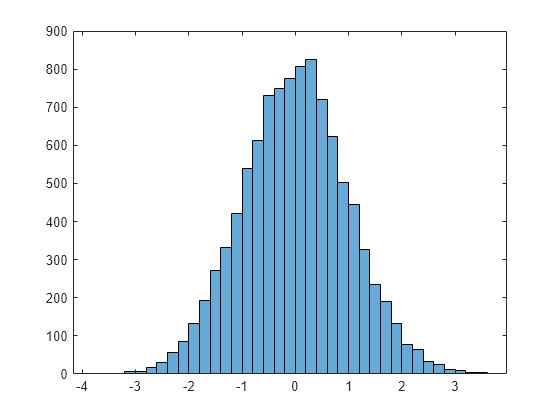
h = Histogram with properties:
Data: [10000x1 double]
Values: [2 2 1 6 7 17 29 57 86 133 193 271 331 421 540 613 730 748 776 806 824 721 623 503 446 326 234 191 132 78 65 33 26 11 8 5 5]
NumBins: 37
BinEdges: [-3.8000 -3.6000 -3.4000 -3.2000 -3 -2.8000 -2.6000 -2.4000 -2.2000 -2 -1.8000 -1.6000 -1.4000 -1.2000 -1 -0.8000 -0.6000 -0.4000 -0.2000 0 0.2000 0.4000 0.6000 0.8000 1.0000 1.2000 1.4000 1.6000 1.8000 2.0000 2.2000 ... ] (1x38 double)
BinWidth: 0.2000
BinLimits: [-3.8000 3.6000]
Normalization: 'count'
FaceColor: 'auto'
EdgeColor: [0 0 0]Use GET to show all properties
When you specify an output argument to the histogram function, it returns a histogram object. You can use this object to inspect the properties of the histogram, such as the number of bins or the width of the bins.
Find the number of histogram bins.
Specify Number of Histogram Bins
Plot a histogram of 1,000 random numbers sorted into 25 equally spaced bins.
x = randn(1000,1); nbins = 25; h = histogram(x,nbins)
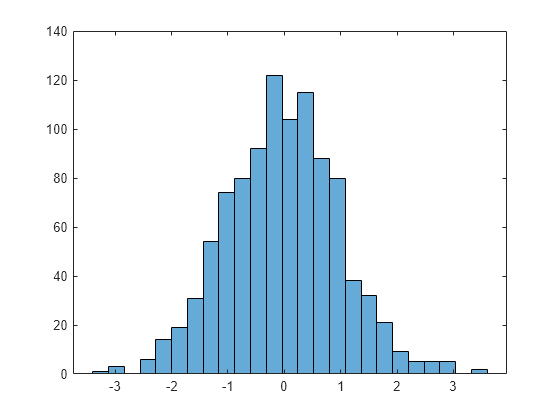
h = Histogram with properties:
Data: [1000x1 double]
Values: [1 3 0 6 14 19 31 54 74 80 92 122 104 115 88 80 38 32 21 9 5 5 5 0 2]
NumBins: 25
BinEdges: [-3.4000 -3.1200 -2.8400 -2.5600 -2.2800 -2 -1.7200 -1.4400 -1.1600 -0.8800 -0.6000 -0.3200 -0.0400 0.2400 0.5200 0.8000 1.0800 1.3600 1.6400 1.9200 2.2000 2.4800 2.7600 3.0400 3.3200 3.6000]
BinWidth: 0.2800
BinLimits: [-3.4000 3.6000]
Normalization: 'count'
FaceColor: 'auto'
EdgeColor: [0 0 0]Use GET to show all properties
Find the bin counts.
counts = 1×25
1 3 0 6 14 19 31 54 74 80 92 122 104 115 88 80 38 32 21 9 5 5 5 0 2Change Number of Histogram Bins
Generate 1,000 random numbers and create a histogram.
X = randn(1000,1); h = histogram(X)

h = Histogram with properties:
Data: [1000x1 double]
Values: [3 1 2 15 17 27 53 79 85 101 127 110 124 95 67 32 27 16 6 6 4 1 2]
NumBins: 23
BinEdges: [-3.3000 -3.0000 -2.7000 -2.4000 -2.1000 -1.8000 -1.5000 -1.2000 -0.9000 -0.6000 -0.3000 0 0.3000 0.6000 0.9000 1.2000 1.5000 1.8000 2.1000 2.4000 2.7000 3 3.3000 3.6000]
BinWidth: 0.3000
BinLimits: [-3.3000 3.6000]
Normalization: 'count'
FaceColor: 'auto'
EdgeColor: [0 0 0]Use GET to show all properties
Use the morebins function to coarsely adjust the number of bins.
Nbins = morebins(h); Nbins = morebins(h)

Adjust the bins at a fine grain level by explicitly setting the number of bins.
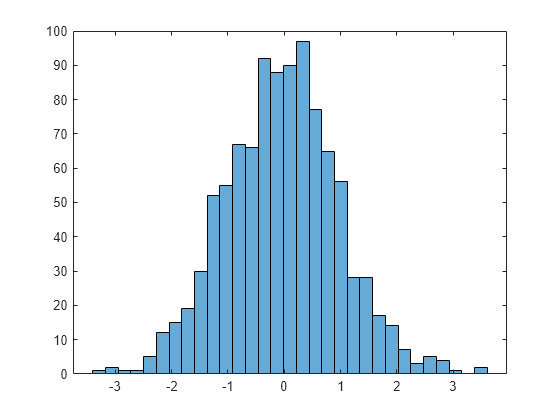
Specify Bin Edges of Histogram
Generate 1,000 random numbers and create a histogram. Specify the bin edges as a vector with wide bins on the edges of the histogram to capture the outliers that do not satisfy |x|<2. The first vector element is the left edge of the first bin, and the last vector element is the right edge of the last bin.
x = randn(1000,1); edges = [-10 -2:0.25:2 10]; h = histogram(x,edges);

Specify the Normalization property as 'countdensity' to flatten out the bins containing the outliers. Now, the area of each bin (rather than the height) represents the frequency of observations in that interval.
h.Normalization = 'countdensity';

Plot Categorical Histogram
Create a categorical vector that represents votes. The categories in the vector are 'yes', 'no', or 'undecided'.
A = [0 0 1 1 1 0 0 0 0 NaN NaN 1 0 0 0 1 0 1 0 1 0 0 0 1 1 1 1]; C = categorical(A,[1 0 NaN],{'yes','no','undecided'})
C = 1x27 categorical no no yes yes yes no no no no undecided undecided yes no no no yes no yes no yes no no no yes yes yes yes
Plot a categorical histogram of the votes, using a relative bar width of 0.5.
h = histogram(C,'BarWidth',0.5)

h = Histogram with properties:
Data: [no no yes yes yes no no no no undecided undecided yes no no no yes no yes no yes no no no yes yes yes yes]
Values: [11 14 2]
NumDisplayBins: 3
Categories: {'yes' 'no' 'undecided'}
DisplayOrder: 'data'
Normalization: 'count'
DisplayStyle: 'bar'
FaceColor: 'auto'
EdgeColor: [0 0 0]Use GET to show all properties
Histogram with Specified Normalization
Generate 1,000 random numbers and create a histogram using the 'probability' normalization.
x = randn(1000,1); h = histogram(x,'Normalization','probability')
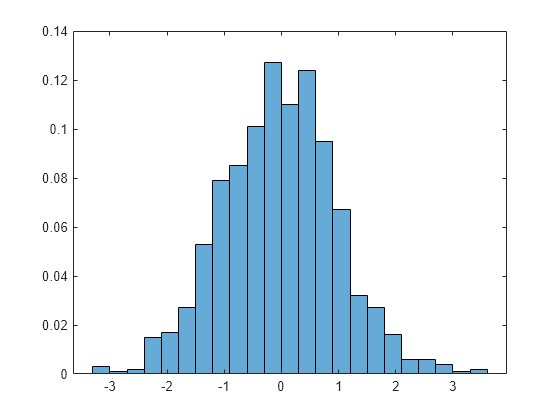
h = Histogram with properties:
Data: [1000x1 double]
Values: [0.0030 1.0000e-03 0.0020 0.0150 0.0170 0.0270 0.0530 0.0790 0.0850 0.1010 0.1270 0.1100 0.1240 0.0950 0.0670 0.0320 0.0270 0.0160 0.0060 0.0060 0.0040 1.0000e-03 0.0020]
NumBins: 23
BinEdges: [-3.3000 -3.0000 -2.7000 -2.4000 -2.1000 -1.8000 -1.5000 -1.2000 -0.9000 -0.6000 -0.3000 0 0.3000 0.6000 0.9000 1.2000 1.5000 1.8000 2.1000 2.4000 2.7000 3 3.3000 3.6000]
BinWidth: 0.3000
BinLimits: [-3.3000 3.6000]
Normalization: 'probability'
FaceColor: 'auto'
EdgeColor: [0 0 0]Use GET to show all properties
Compute the sum of the bar heights. With this normalization, the height of each bar is equal to the probability of selecting an observation within that bin interval, and the height of all of the bars sums to 1.
Histogram Using Percentages
Generate 100,000 normally distributed random numbers. Use a standard deviation of 15 and a mean of 100.
x = 100 + 15*randn(1e5,1);
Plot a histogram of the random numbers. Scale and label the _y_-axis as percentages.
edges = 55:15:145; histogram(x,edges,Normalization="percentage") ytickformat("percentage")

Plot Multiple Histograms
Generate two vectors of random numbers and plot a histogram for each vector in the same figure.
x = randn(2000,1); y = 1 + randn(5000,1); h1 = histogram(x); hold on h2 = histogram(y);
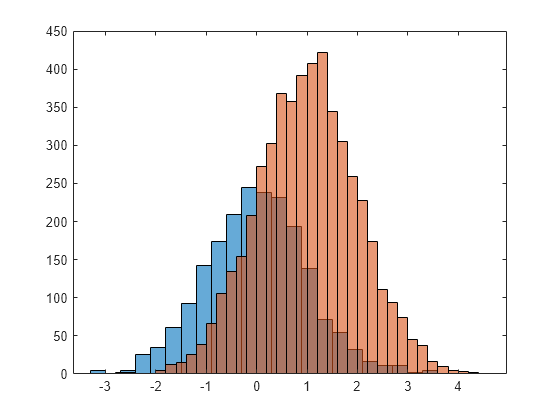
Since the sample size and bin width of the histograms are different, it is difficult to compare them. Normalize the histograms so that all of the bar heights add to 1, and use a uniform bin width.
h1.Normalization = 'probability'; h1.BinWidth = 0.25; h2.Normalization = 'probability'; h2.BinWidth = 0.25;

Modify Histogram Properties
Create a histogram and return the Histogram object. Use the Histogram object to modify properties of the histogram after creating it.
x = randn(1000,1); h = histogram(x)
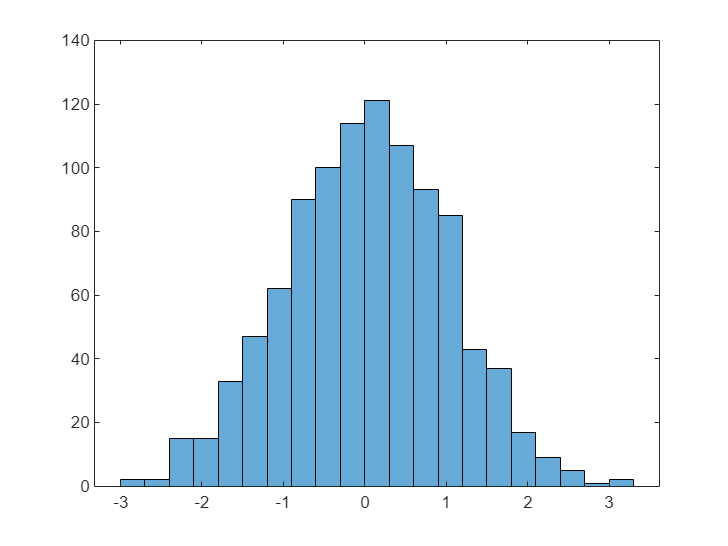
h = Histogram with properties:
Data: [1000×1 double]
Values: [2 2 15 15 33 47 62 90 100 114 121 107 93 85 43 37 17 9 5 1 2]
NumBins: 21
BinEdges: [-3.0000 -2.7000 -2.4000 -2.1000 -1.8000 -1.5000 -1.2000 -0.9000 -0.6000 -0.3000 0 0.3000 0.6000 0.9000 1.2000 1.5000 1.8000 2.1000 2.4000 2.7000 3.0000 3.3000]
BinWidth: 0.3000
BinLimits: [-3.0000 3.3000]
Normalization: 'count'
FaceColor: 'auto'
EdgeColor: [0 0 0]Show all properties
Specify the edges of the bins with a vector.

Normalize the bin counts so that the maximum bin count is 1.
h.BinCounts = h.BinCounts/max(h.BinCounts);

Label Bars with Bin Counts
You can label each rectangular bar of a histogram with the number of elements it represents.
Create a histogram.
x = randn(1000,1); h = histogram(x,5);
Return the bin counts and the _x_-axis position of each bin center.
counts = h.Values; binEdges = h.BinEdges; binCenters = binEdges(1:end-1) + diff(binEdges)/2;
Add a label to each bar that displays the number of elements it represents.
text(binCenters,counts,num2str(counts'),HorizontalAlignment="center",VerticalAlignment="bottom")

Determine Underlying Probability Distribution
Generate 5,000 normally distributed random numbers with a mean of 5 and a standard deviation of 2. Plot a histogram with Normalization set to 'pdf' to produce an estimation of the probability density function.
x = 2*randn(5000,1) + 5; histogram(x,'Normalization','pdf')

In this example, the underlying distribution for the normally distributed data is known. You can, however, use the 'pdf' histogram plot to determine the underlying probability distribution of the data by comparing it against a known probability density function.
The probability density function for a normal distribution with mean μ, standard deviation σ, and variance σ2 is
f(x,μ,σ)=1σ2π exp[-(x-μ)22σ2].
Overlay a plot of the probability density function for a normal distribution with a mean of 5 and a standard deviation of 2.
hold on y = -5:0.1:15; mu = 5; sigma = 2; f = exp(-(y-mu).^2./(2sigma^2))./(sigmasqrt(2*pi)); plot(y,f,'LineWidth',1.5)

Saving and Loading Histogram Objects
Use the savefig function to save a histogram figure.
histogram(randn(10)); savefig('histogram.fig'); close gcf
Use openfig to load the histogram figure back into MATLAB®. openfig also returns a handle to the figure, h.
h = openfig('histogram.fig');
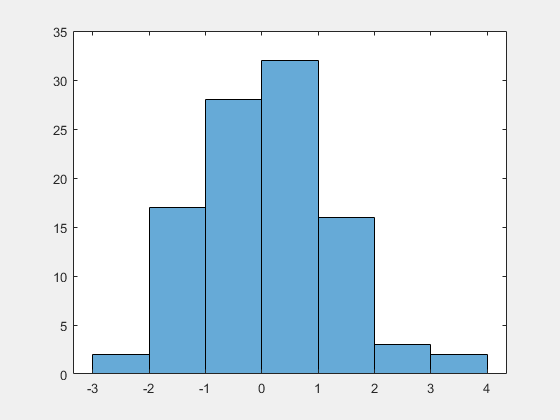
Use the findobj function to locate the correct object handle from the figure handle. This allows you to continue manipulating the original histogram object used to generate the figure.
y = findobj(h,'type','histogram')
y = Histogram with properties:
Data: [10x10 double]
Values: [2 17 28 32 16 3 2]
NumBins: 7
BinEdges: [-3 -2 -1 0 1 2 3 4]
BinWidth: 1
BinLimits: [-3 4]
Normalization: 'count'
FaceColor: 'auto'
EdgeColor: [0 0 0]Use GET to show all properties
Tips
- Histogram plots created using
histogramhave a context menu in plot edit mode that enables interactive manipulations in the figure window. For example, you can use the context menu to interactively change the number of bins, align multiple histograms, or change the display order. - When you add data tips to a histogram plot, they display the bin edges and bin count.
Extended Capabilities
Tall Arrays
Calculate with arrays that have more rows than fit in memory.
This function supports tall arrays with the limitations:
- Some input options are not supported. The allowed options are:
'BinWidth''BinLimits''Normalization''DisplayStyle''BinMethod'— The'auto'and'scott'bin methods are the same. The'fd'bin method is not supported.'EdgeAlpha''EdgeColor''FaceAlpha''FaceColor''LineStyle''LineWidth''Orientation'
- Additionally, there is a cap on the maximum number of bars. The default maximum is 100.
- The
morebinsandfewerbinsmethods are not supported. - Editing properties of the histogram object that require recomputing the bins is not supported.
For more information, see Tall Arrays for Out-of-Memory Data.
GPU Arrays
Accelerate code by running on a graphics processing unit (GPU) using Parallel Computing Toolbox™.
The Histogram function supports GPU array input with these usage notes and limitations:
- This function accepts GPU arrays, but does not run on a GPU.
For more information, see Run MATLAB Functions on a GPU (Parallel Computing Toolbox).
Distributed Arrays
Partition large arrays across the combined memory of your cluster using Parallel Computing Toolbox™.
Usage notes and limitations:
- This function operates on distributed arrays, but executes in the client MATLAB.
For more information, see Run MATLAB Functions with Distributed Arrays (Parallel Computing Toolbox).
Version History
Introduced in R2014b
R2023b: Normalize using percentages
You can create histograms with percentages on the vertical axis by setting theNormalization name-value argument to'percentage'.
